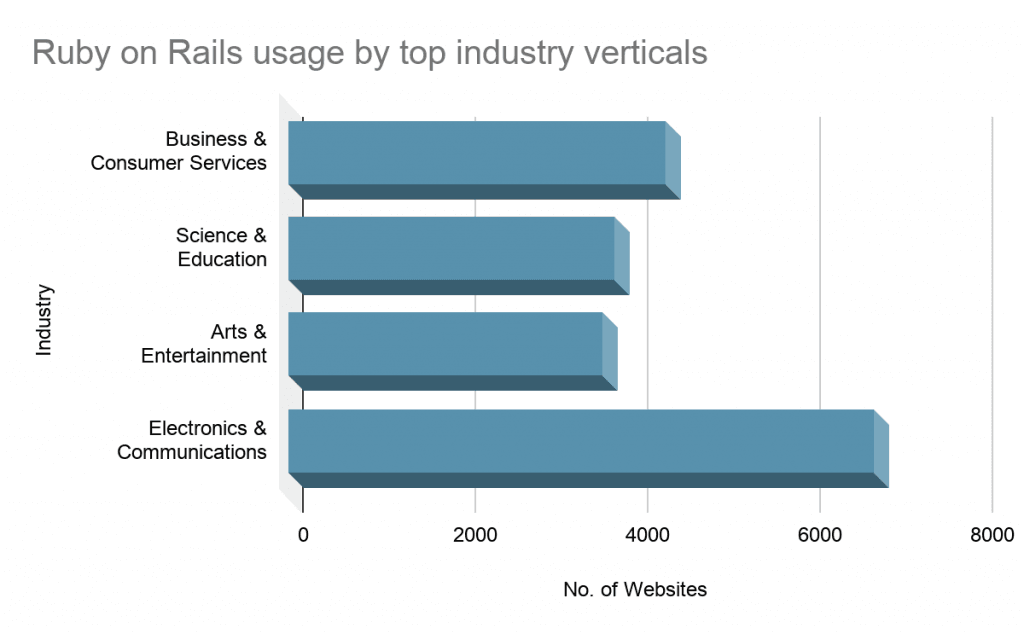 By Jeevan Babu February 2, 2021
12 min read
By Jeevan Babu February 2, 2021
12 min readTop 5 backend development frameworks that are set to revolutionize in 2021
Why do you need a framework for software development?
Frameworks aim to automate the software development overheads. Leveraging the benefits of frameworks such as time-saving, scalability, robustness, security, integrations, frameworks have become an integral part of web development with the rising standards and complexities associated with it.
Usually, web development is thought of as client and server. Users directly interact with the clients through websites and apps. The client sends a request to the server and the server serves back the requested content to the client. In other words, the backend provides logic for your website’s functionality and sends the appropriate data to the client. Also, the backend has a database that stores the application data.
To embrace the power of frameworks for building rich and interactive web applications, you need to know the best-suited framework for your project.
Let’s dive into the details of the top 5 backend frameworks for web development
Django
Based on the Python programming language, Django is a leading open-source backend framework that follows the MVC pattern. Django’s popular use cases include sophisticated and feature-rich database-driven websites and applications such as Instagram, Pinterest, and Coursera.
With Django, you get a host of benefits such as optimized pluggability, less coding, greater reusability, and quicker development to leverage. Django uses Python for all its operations including build, read, modify, and delete. Some popular websites such as The Washington Times, Mozilla have Django’s contribution.
Pros of Django
Speed: The entire development process is fast due to Django’s low learning curve and ease of use.
Feature-rich: Django offers a broader array of features to users to help in tasks such as user authentication, content administration, sitemaps, and many more.
Enhanced security: Django offers optimal security solutions against cross-site scripting, clickjacking SQL injection, and request forgery. It offers a user authentication system that helps them with a secure password and account storage and management.
Scalability: Offers a high-level of scalability, attracting some of the world’s top websites for seamlessly catering to their changing operational demands.
Versatility: Django framework is versatile and is used in building applications from domains like social networking, CMS, computing platforms, to name a few among others.
Cons
- It lacks conventions
- It’s not suitable for smaller projects
- It has a monolithic framework
Features of Django
- Open-source
- Simple to use
- Reliable
- Simple syntax
- MVC core architecture
- Object Relational Mapper
- HTTP libraries
- Middleware support
- Owns a web server, a framework, and components
Popular websites and applications that use Django
- Disqus
- YouTube
- Spotify
- Mozilla
- DropBox
Laravel
An open-source PHP web framework, Laravel follows an MVC architecture and is used to build Symphony-based web applications. Laravel offers a modular packaging system equipped with a dedicated dependency manager. Laravel offers multiple ways of accessing relational databases in addition to application maintenance and deployment utilities. Also, Laravel has an MIT license and a source code that is hosted on GitHub. All these factors make Laravel an ideal choice for PHP web application development.
Pros
Quick development cycle: Offers faster development due to quicker integrations and huge community support.
Documentation: Each version of Laravel was released with precise documentation with clear and easy descriptions of classes, approaches, and code types making it developer-friendly.
Caching: Laravel supports popular cache backends such as Redis, Memcache, enabling you to create and set up multiple configurations.
Artisan: It allows developers to build skeletal codes, control the database, and generate and maintain simple MVC files with their respective settings.
Managing queues: Shorten the user response time by removing the tasks that are irrelevant or unnecessary.
Reverse routing: This allows the creation of links within the structure to named routes
IOC container: This allows the creation of new objects without the need of bootstrapping outside libraries.
Eloquent ORM: A built-in ORM implementation that allows you to work with the database objects and relationships with an eloquent and expressive syntax
Seamless integration with mail services: Laravel supports integration with mail services and offers drivers for SMTP, Mailgun, Mandrill, Sendmail, Amazon SES, and SparkPost. It supports sending of email through local or cloud-based services
Security: Offers robust security facilities with the salted and hashed password modalities. Laravel uses the Bycrypt Hashing algorithm for generating encrypted passwords. Also, Laravel helps in reducing injection attacks by utilizing prepared SQL statements.
Cons
- Less in-built support
- Possibilities of problems with certain upgrades
- Require some experience to start with
Features
- Easy authentication
- Automatic testing
- Configuration error and exception handling
- MVC architecture support
- Caching
- Modularity
- Namespaces
- Overloading
- Anonymous functions
- Interfaces
- Shorter array syntax
Popular website and applications built using Laravel
- Koel
- Creative Spaces
- Neighborhood Lender
- Morgans Hotel Group
- Invicta Watch Group
- Deltanet Travel
Ruby on Rails
Ruby on Rails (RoR) or Rails as popularly known, is a server-side web application framework that has an MIT license. RoR is an MVC framework that offers database default structures, web pages, and web services.
Rails use CSS, JavaScript, and HTML for interfacing, and XML or JSON for data transfers. Software engineering patterns namely active record pattern, convention over configuration (CoC), and don’t repeat yourself (DRY) are prioritized by Rails.
Rails has some popular use cases to its credit such as Dribbble, GitHub, Airbnb, Basecamp, to name a few among the others.

The graph below shows the top industry verticals where RoR is used. RoR is used by over 394,361 websites today. Fig. Graph of Ruby on Rails usage by top industry verticals
Pros
Efficiency: Accelerates and simplifies coding experience due to its dedicated and growing community and efficient tools.
Wide range of tools and libraries: Offers a plethora of tools and libraries for simplifying debugging, testing, and optimization tasks.
Community: RoR consists of a huge and active community on GitHub where you get “gems” with specific functions and can be utilized in your projects.
Adherence to standards: As mentioned at the beginning RoR follows software design paradigms such as “coding by convention” (specifying the unconventional app features), “don’t repeat yourself” (Preventing code duplication and support for creating abstractions instead) and “active record pattern” (A defined way of accessing data in the database).
Faster development: Shorter time to market your web app if RoR is used for development as RoR comes with a lot of plugins and modules making reading, writing, and modifying codes much faster.
Consistency: Ruby on Rails offers structural consistency and readability of a project by providing developers the ability to use standardized file storage systems and programming conventions while saving a lot time
Cost-effective: Users can acquire the potentials of RoR without paying as Ruby on Rails is open-source and offered under the MIT license. With Gems, adding features is hassle-less and requires no development from scratch.
Quality development: Achieve bug-free software development with Ruby on Rails. It leverages the power of Minitest tool that provides testing features such as mocking, expectation syntax, and test benchmarking. Behavior-driven deployment (BDD) and test-driven deployment (TDD) approaches are used for reducing cost of development and RoR supports both.
Scalability: Ruby on Rails is well-suited and popular for websites that service a high volume of customers.
Cons
- Slow runtime speed
- Difficult to scale
- Lack of flexibility
- High cost incurred to cover development mistakes
Features
- MVC architecture
- Open-source
- Automated deployment
- Simple programming language
- Secure and scalable
- Huge library
- Easy learning curve
- Simplified testing
- Active Record for effortless database interaction query design
- Follows a “Convention over Configuration” approach for automatic assignment of value without user intervention
Websites and applications built using RoR
- Etsy
- Bloomberg
- Shopify
- Airbnb
- Twitch
- GitHub
Express.js
Express or Express.js is an open-source Node.js web application framework that is used for building APIs and web applications. This framework is available under the MIT license.
Express is a standard Node.js server framework and is a MEAN and MERN stack backend component.
Express.js is a boon for the developers who are looking to build efficient web apps in a shorter period of time. Node.js has the potential to handle thousands of client requests at the same time.
Pros
Learning curve: Easy learning curve as front-end developers are familiar with JavaScript, thus requiring less time and effort
Single programming language for both front-end and back-end: Web developers use JavaScript as a single programming language for both front-end and back-end development.
Faster development: Quick and easy implementation of code as JavaScript code is interpreted through Google V8 JavaScript Engine by Node.js and enhancing performance
Customization: Express.js framework can be easily customized tailored to your business needs.
Middleware: Offers a flexible middleware module for doing extra tasks on response and request and organizes different functions of Express.js
Cons
- Not recommended for larger projects
- Not suitable for highly-scalable apps that are performance critical
Features
- Quicker development at the server-side
- Systematic organization of different functions with Middleware
- Offers a highly advanced routing mechanism
- Offers templating engine to build dynamic content on the web page
- Easy debugging
Websites built using Express.js
- MySpace
- LearnBoost
- Klout
- PayPal
- Groupon
- Secret
CakePHP
A widely used open-source framework, CakePHP is written in PHP and is based on the Ruby on Rails concepts. It follows the MVC architecture and is available under MIT license. It is a popular choice for leading web development companies due to its advanced features that it offers. CakePHP uses popular software design and engineering concepts like active record, MVC, convention over configuration approach, data mapping to name a few among the others.
Pros
Support for different models: Support for a wide range of software development models including MVC. Also, with CakePHP, large web applications can easily be maintained and updated.
Code generation and Scaffolding: Supports rapid creation of prototypes and reusable code, supporting rapid creation of new PHP applications using existing code in different projects
Code reusability: This helps the developers more productive, reducing overall development time
Database management: Feature automation affects database management and simplifies the database setup and begins application development without using complex XML or YAML files.
Templating: CakePHP offers a fast and flexible templating system to enhance application look and feel with custom templates.
Easy defining of functions: CakePHP offers web developers direct access to Core and App directories making it easy to define the functions of each class in a much simpler way
Built-in tools: CakePHP offers innovative built-in tools that make web applications safe and secure by preventing web applications from SQL injection and cross site scripting (XSS) attacks. Also, they help web experts to validate user input, and prevent form tampering and CSRF.
Cons
- Non-comprehensive documentation
- No support for default routes for fancy URLs
- Difficulties in migrating from version 2.x to 3.x
Features
- Open-source framework
- MVC architecture
- Built-in ORM
- Code reusability
- Scaffolding
- Reverse routing
- Multiple language support option
- Caching configuration
Popular websites built using CakePHP
- Education Unlimited
- MapMe
- Followmy TV
- Elite performance and fitness
- MyGasFeed
In a nutshell
Here we have listed the top 5 backend frameworks each with their pros, cons, features, and popular applications. To choose the best backend framework for your project, you need to go thoroughly on factors such as project scope, documentation, learning curve, libraries, security, and scalability. This list of top 5 backend frameworks to consider in 2021 will definitely help you to narrow your search in the available pool of choices irrespective of you being a startup or SME or a leading enterprise.
Author Bio


 Facebook
Facebook Whatsapp
Whatsapp LinkedIn
LinkedIn Pinterest
Pinterest




 Start Chat
Start Chat